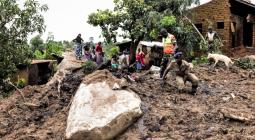Fears back-to-back cyclones may have damaged Great Barrier Reef
Strong waves and sediment-laden freshwater pushed out from river catchments may have damaged parts of reef system, experts say
Back-to-back cyclones crossing the Great Barrier Reef have experts concerned vast flood plumes and heavy waves may have damaged parts of the world’s biggest coral reef system.
Reef scientists and conservationists went into the summer worried that an El Niño weather pattern would elevate the risk of mass coral bleaching.
But so far the greatest concerns have come from December’s Cyclone Jasper and last week’s Cyclone Kirrily, which have seen river catchments push out vast quantities of freshwater laden with sediments and nutrients.
The fears come just days before a 1 February deadline for the federal government to report on commitments to protect the reef to Unesco, to avoid it being placed on a list of world heritage sites in danger.
Freshwater can cause corals to bleach and turbid water can starve reefs and seagrass meadows of light and promote the growth of algae, making it harder for corals to grow and multiply.
Cyclones also whip up strong waves that can damage reefs and tear up seagrass meadows that are habitats for dugongs and turtles and act as nurseries for fish.
Despite cyclones usually helping to cool waters, the Great Barrier Reef Marine Park Authority (GBRMPA) told the Guardian that sea surface temperatures remained at least 1C above average across the reef.
Dr Jane Waterhouse, a water quality scientist at James Cook University’s TropWater research group, said there appeared to be “no relief for the reef”.
“We’re quite concerned about the potential impacts from the run-off on the reefs in the northern areas,” she said.
Marine ecosystems “do not like freshwater”, she said, and some freshwater bleaching had already been observed this summer.
Satellite images reviewed by TropWater in late December showed the discharge from rivers from torrential rains delivered by Cyclone Jasper had extended beyond the reefs closer to shore.
Dr Stephen Lewis, a water quality expert also at TropWater, said Cyclone Jasper had hit at the end of the sugar cane crushing season when paddocks had been freshly applied with fertilisers and pesticides.
He said the timing increased the chances of those nutrients flowing into the reef, but said there was little farmers would have been able to do to prevent it. It was too early to know the extent of flood plumes from Cyclone Kirrily.
But Lewis said flood monitoring had a major “research gap” because water samples were only taken from inshore reefs.
He said water monitoring needed to be extended to better understand how land-based runoff affected reefs farther offshore.
Waterhouse said a new pattern could be emerging under climate change where coral bleaching was interspersed with intense rainfall, giving little time for recovery.
Dr Roger Beeden, the chief scientist at the GBRMPA, said: “We’ve had a large inflow of water and you would expect to see some impacts there, and not just on corals.”
Early reports from monitoring suggested the impacts on corals from Cyclone Jasper may not have been as bad as feared. There were only isolated reports of bleaching, he said.
But he added: “This summer is not over in terms of the pressures that are there.”
While cyclones can damage reefs and cause flood plumes, they can also help cool ocean temperatures and reduce the risk of coral bleaching.
But the US National Oceanic and Atmospheric Administration’s (NOAA) Coral Reef Watch showed on Monday that some inshore reef areas had enough heat stress to cause bleaching.
Beeden said forecasts from the Bureau of Meteorology and the NOAA suggested conditions would remain warm over the reef for the next couple of months.
“We are not going to see the kind of impacts from [back-to-back mass bleaching events] in 2016 and 2017, but these cumulative impacts are a concern on the ability of corals to grow and reproduce.”
The federal government will need to hand a progress report to Unesco on its conservation plans for the reef by Thursday, after committing last year to improving water quality and bringing climate targets in line with keeping global heating to 1.5C.
Richard Leck, the head of oceans at WWF Australia, said: “What we are seeing from these massive flood plumes really calls on Queensland and the commonwealth to increase their efforts around catchments, especially on tree clearing.
“We still clear about 100,000 hectares around the catchments of the reef every year, and it’s legal. That means the laws are not fit for purpose.”
Leck said the Queensland government would be able to report new state climate targets, announced in December, to cut emissions by 75% by 2035 based on 2005 levels.
He said: “Queensland with its heavy industry is one of the hardest states to decarbonise. If Queensland can make those commitments, then surely as a nation we can meet that.”
Cover photo: December’s Cyclone Jasper and last week’s Cyclone Kirrily may have damaged parts of the Great Barrier Reef in Queensland, scientists and conservationists say. Photograph: Darren England/AAP





